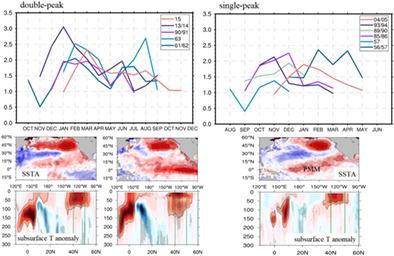当前位置:
X-MOL 学术
›
Int. J. Climatol.
›
论文详情
Our official English website, www.x-mol.net, welcomes your feedback! (Note: you will need to create a separate account there.)
Two types of warm blobs in the Northeast Pacific and their potential effect on the El Niño
International Journal of Climatology ( IF 3.9 ) Pub Date : 2020-12-29 , DOI: 10.1002/joc.6991 Ziyan Chen 1, 2 , Jian Shi 1, 2 , Chun Li 1, 2
International Journal of Climatology ( IF 3.9 ) Pub Date : 2020-12-29 , DOI: 10.1002/joc.6991 Ziyan Chen 1, 2 , Jian Shi 1, 2 , Chun Li 1, 2
Affiliation

|
In recent years, the predominant marine heatwaves in Northeast Pacific, the so‐called warm blobs, have exerted substantial environmental and socioeconomic influences on North America and its coastal waters. We select the historical warm blob events from 1951 to 2018 and divide them into double‐peak and single‐peak categories by their seasonal evolutions. The heat budget analyses attribute the leading contributor of double‐peak warm blobs to the surface heat flux at the first wintertime maximum while the vertical entrainment and diffusion take responsibility for the second peak 5 months later. The positive net heat flux anomalies indicate less heat loss from ocean to the atmosphere due to an exceptionally anomalous high as the northern lobe of the North Pacific Oscillation and intensive easterly anomalies, which counteract with the climatological westerlies. For the single‐peak category, the vertical entrainment and diffusion primarily trigger the warm blob and also lead to its termination. Moreover, the single‐peak warm blob induces positive sea surface temperature (SST) anomalies near the Baja California and establishes the Pacific Meridional Mode as the oceanic bridge to convey its influence onto the tropics and trigger the following El Niño around 10 months after the peak. In addition, the subsurface processes, such as the trade wind charging mechanism, also play an essential part by bringing warmer water upwards to the surface and hence cause the positive SST anomalies in equatorial central‐eastern Pacific. However, the interim connection between the double‐peak warm blob and El Niño is not very clear although their intensities appear to be stronger.
中文翻译:

东北太平洋的两种类型的温暖斑点及其对厄尔尼诺现象的潜在影响
近年来,东北太平洋的主要海洋热浪,即所谓的暖波,对北美及其沿海水域产生了重大的环境和社会经济影响。我们选择1951年至2018年的历史性暖斑事件,并根据季节变化将其分为双峰和单峰类别。热预算分析将双峰暖峰的主要贡献者归因于冬季第一个冬季最高点的表面热通量,而垂直夹带和扩散则是5个月后的第二个高峰的原因。正净热通量异常表明,由于北太平洋涛动的北瓣异常高和东风强烈,异常从海洋到大气的热损失减少,与气候西风相抵消。对于单峰类别,垂直夹带和扩散主要触发温暖的斑点,并导致其终止。此外,单峰暖波在下加利福尼亚州附近诱发正海面温度(SST)异常,并建立太平洋子午线模式作为海洋桥梁,以将其影响传递给热带并在高峰后约10个月触发随后的厄尔尼诺现象。 。此外,地下过程,例如商业风的充电机制,也通过将温暖的水向上带到地表而发挥重要作用,从而在赤道中东部太平洋造成正的海表温度异常。然而,
更新日期:2021-03-09
中文翻译:

东北太平洋的两种类型的温暖斑点及其对厄尔尼诺现象的潜在影响
近年来,东北太平洋的主要海洋热浪,即所谓的暖波,对北美及其沿海水域产生了重大的环境和社会经济影响。我们选择1951年至2018年的历史性暖斑事件,并根据季节变化将其分为双峰和单峰类别。热预算分析将双峰暖峰的主要贡献者归因于冬季第一个冬季最高点的表面热通量,而垂直夹带和扩散则是5个月后的第二个高峰的原因。正净热通量异常表明,由于北太平洋涛动的北瓣异常高和东风强烈,异常从海洋到大气的热损失减少,与气候西风相抵消。对于单峰类别,垂直夹带和扩散主要触发温暖的斑点,并导致其终止。此外,单峰暖波在下加利福尼亚州附近诱发正海面温度(SST)异常,并建立太平洋子午线模式作为海洋桥梁,以将其影响传递给热带并在高峰后约10个月触发随后的厄尔尼诺现象。 。此外,地下过程,例如商业风的充电机制,也通过将温暖的水向上带到地表而发挥重要作用,从而在赤道中东部太平洋造成正的海表温度异常。然而,



























 京公网安备 11010802027423号
京公网安备 11010802027423号